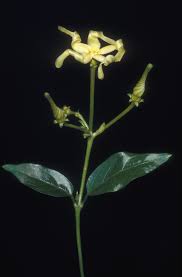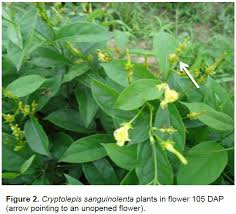Cryptolepis sanguinolenta (Lindl.) Schlt
| Botanical Name | Cryptolepis sanguinolenta (Lindl.) Schlt |
| Order: | Gentianales |
| Family: | Apocynaceae |
| Genus: | Cryptolepis |
| Species: | C. sanguinolenta |
| Common Names: | Ghana quinine; yellow-dye root, French; Quinine du Ghana |
Plant Synonyms
Pergularia sanguinolenta Lindl; C. triangularis N.E. Br.
Plant Local Names
Cote d'lvoire: Anyi - Alui Okie
Ghana: Twi - Nibima, Ewe - Kadze, Hausa - Gangaman
Guinea Bissau: Banyan - Konit, Diola - Fu lemok, Vulgar balanta - Butnacimbore
Guinea: Fula pulaar - Delboi, Manding bambara uiduloia, Maninka- nombon
Nigeria: Hausa - Gangamaa, Igbo (Ogwashi) - Kpolokoto
Senegal: Balanta-butnasimbor, Diola flup- Ahayte buka Ka, Bambara - Idukokoy
Sierra Leone: Koranko - Firabantikpa, Mende - Kpokoyangole
Togo: Ewe - Kedze, Ouatchi - Anotsidzen, Mina – Kadzen
Plant Habitat
Indigenous to Africa and found in places such as Central, Eastern, and Western Africa (Tona et ai, 1998; Silva et ai, 1996; Oliver-Bever, 1986). Commonly grows in scattered open spaces, usually among forest clearings (Luo et ai, 1998; GHP, 1992).
Plant Material of Interest
Root, Leaf and stem
Plant Description
Thin-stemmed twining or scrambling shrub; leaves elliptic, oblong-elliptic, apex acute to shortly acuminate, base symmetrical, petiolate, up to 7 cm long and 3 cm wide, glabrous; inflorescence cyme, lateral on branch shoots; few flowered, corolla tube up to 5 mm long, yellow; fruits pair of follicles linear; seeds with, long silky hairs. The dried plant is sweet-scented and the root has a bitter taste.
Plant Used Parts
Plant Uses
Aqueous extract of cryptolepis is used by the Fulani traditional healers in Guinea-Bissau to treat jaundice and hepatitis (Oliver-Bever, 1986 In Zaire and the Casamance district of Senega infusions of the roots are used in the treatment of stomach and intestinal disorders (Silva et a 1996; Kerharo and Adam, 1974). In Ghana, dried root decoctions of the herb, prepared by boiling the powdered root in water, are used in treatirg various forms of fever, malaria, urinary and uppe-1 respiratory tract infections, rheumatism and venereal diseases. An aqueous decoction of the root bark is used in Congolese traditiona medicine for the treatment of amoebiasis (Boye 1989).
Plant Therapeutic Action
Antibacterial; antiinflammatory; antimalarial (chloroquine-sensitive and chloroquine- resistant -strains); antipyretic; antiviral; hypoglycaemic;hypotensive (Addy, 2003; GHP, 1992; Iwu, 1993; Silva, 1996; Brierer, 1998).
Plant Precaution for Use
Pregnancy should be excluded in the administration of the aqueous extract. Care should be taken when driving or operating machinery.
Plant Adverse Effect
Results from animal studies suggest that the aqueous extract may cause sedition, low sperm count arid possible spontaneous abortion in over-dosage but this has not been demonstrated in humans.
Plant Contraindication
Pregnancy, low sperm count, gastric ulceration
Plant Dosage Forms
Infusion: 2.5 g teabag of root bark soaked in 150 ml (1 cup) of boiling'1 water; steep for 5-10 minutes (Boye, 2002). Decoction: 40 g per litre of water, 3-5 teacupfuls daily
Tincture: 1:5 in 45% alcohol, 5 ml three times daily
Plant Dosage
Decoction; infusion; tincture
Plant Storage
Store in a cool dry-place.
Plant Chromatographic Fingerprint
Plant Constituents
Cryptolepine, quindoline, a phenolic derivative of cryptolepine and two other uncharacterised alkaloids (Addy, 2003; Bierer et al., 1998; Paulo ot al., 1995; Dwuma-Badu et al., 1978; Gellert et al., 1951).
Plant Pictures
Plant References
Addy, M. (2003). Cryptolepis: An African Traditional Medicine that Provides Hope for Malaria Victims. HerbalGram 60:54-59, 67.
Ansah, C., Zhu, M.., Gooderham, N.J. (2008). The mechanism of cryptolepine-induced, cell death. Journal of Pharm'acOlogy Toxicology, 3: 291-301.
Bamgbose, S.OA Noamesi, B.K. (1981). Studies on ciyptolepine Inhibition of
carrageenan-induped oedema by cryptolepine. Planta Medica, 41;392 - 396.
Boakye-Yiadom, ( K. (1979). Antimicrobial properties of some West African medicinal plants. II. Antimicrobial activity of aqueous extracts of Cryptolepis sanguinolenta(Lindl.) Schlechter. Quart Journal of prude Drug Research, 17:78-80.
Bonjean, K., DePauw-Gillet, M.C., Defresne,, M.P. et al., (1988). The DNA intercalating alkaloid cryptolepine interacts with topoisomerase II and inhibits primarily DNA synthesis in B16 melanoma cells. Biochemistry 37:5136-46.
Boye, G.L. (1989). Studies on antimalarial action of Cryptolepis sanguinolenta extract. Proceedings of tine International Symposium on East-West Medicine; Seoul, Korea, 243-51.


